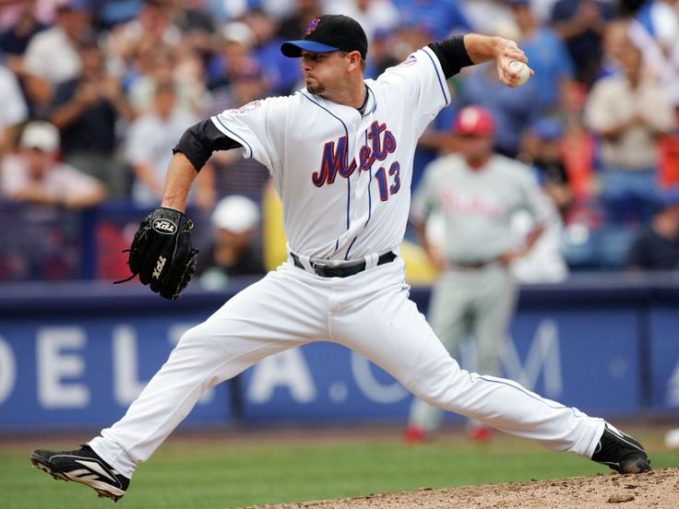There are 10 players eligible for induction into the Hall of Fame who have the Mets on some portion of their resume. Next is one of the best in major league history, who spent three-and-half-years in New York and who’s on the doorstep of Cooperstown.
If you’re a 5-foot-10 left-hander, throwing 100 miles per hour in the 1990s doesn’t compute—more so if you figured out how to throw lefty after breaking your dominant right arm as a child. Billy Wagner and his relatively small frame defied baseball logic. By reaching triple digits on the radar gun with regularity, he was among the best hard-throwing relievers of his time.
Wagner wasn’t merely a flamethrower, he was very effective too. He accumulated 422 saves in his 16-year career, good for sixth all-time. He totaled 1,196 strikeouts and had a 2.31 ERA. He was named an All-Star seven times and reached the postseason seven times.
Wagner locked down games for the Astros, Phillies, Red Sox, and Braves. With Houston, he fanned more than 12 per nine innings. Over two years with Philly, his WHIP was barely over 0.800. But after burning bridges in the city of Brotherly Love, Wagner joined its closest rival and bolstered the Mets’ chances of taking supremacy in the NL East.
Over three-plus seasons in New York, Wagner was an All-Star twice, registered 101 saves, fanned 230 batters, and had a 2.37 ERA with a 1.054 WHIP. His initial year was one of the best of his career, ultimately finishing with 40 saves and a 2.24 ERA for the NL East champs and even garnering Cy Young Award votes.
His next two seasons each started out well but ended in disappointment—first in ’07 when he struggled down the stretch and then in ’08 when he suffered an injury that took him out of action for much of ’09. He returned for just a few appearances as a Met that August before joining the Red Sox. It seemed as if his career was on the verge of petering out, but instead, he rebounded with a solid 2010 performance in Atlanta, posting a 1.43 ERA and 37 saves for the Braves.
Even after being an elite performer in his specialty for more than a decade, Wagner is still waiting to make the Hall. This is not uncommon for relievers. It happened prior to the eventual elections of Bruce Sutter, Goose Gossage, and Lee Smith. And now it’s happening to Wagner. There’s strong evidence to believe he’ll break through in one of his final two tries on the writer’s ballot. Wagner has picked up support in recent years, with the latest bringing him up to 68.1 percent.
The Case For
Wagner’s numbers stack up very well when you compare him to his fireman brethren. There are eight players who were primarily relief pitchers currently in the Hall of Fame. His career ERA of 2.31 is better than four who already have plaques: Trevor Hoffman, Dennis Eckersley, Rollie Fingers, and Hoyt Wilhelm. His career ERA+ of 187 is higher than everyone except for Mariano Rivera.
While his fourth-place ranking on the strikeout list among relievers is quite good, his 11.92 strikeout per nine-inning rate sits atop the all-time list for any pitcher to have thrown at least 900 innings. So, too, is his .187 opponents batting average. That, plus his 0.997 career WHIP is the second lowest all-time. All of this in a time when pitchers were at the mercy of an environment that completely favored hitters.
When using the JAWS metric, a benchmark that formulates a player’s value, Wagner is the sixth-best closer by that standard. And the five relievers better than him are already in the Hall: Riveray, Eckersley, Wilhelm, Gossage and Hoffman.
The Case Against
If we had to point to a couple of factors that would sway voters away from Wagner being a Hall of Famer, it would be the amount of work and postseason performance.
He logged 903 career innings on the mound. If elected, that would be the fewest any pitcher enshrined in Cooperstown (going under the previous low of Bruce Sutter at 1,042). Granted, we’re going to see more pitchers become eligible for the Hall—both starters and relievers —whose innings pitched will be lower than those who came before them. The days of Sutter and Gossage and Fingers entering a game and pitching multiple innings are long gone. That said, Wagner’s workload over a 16-season span could very well be a detraction.
So, too, could how he performed in the playoffs. For some reason, Wagner was not overly effective in these situations. Over seven different postseasons, he made 14 appearances and threw 11.2 innings. He allowed 21 hits and 13 earned runs. A 10.03 ERA in that small of a sample size still isn’t a good look, considering the circumstances.
Final Thoughts
Let’s get this out of the way. Not only should he make it in this upcoming ballot, but he should have been in already. Both the numbers and the eye test (for those who were able to watch him at his best) prove how great he was. When your prime exists in the same span as Mariano Rivera, it’s easy to be overshadowed.
But just like Tim Raines‘ base stealing prowess in the 1980s was obscured by the insane dominance of Rickey Henderson, Wagner shouldn’t be punished for that. It’s time Wagner get’s his due. Just like he did more than 400 times in his playing career, let’s see if the voters can close it out for him.
















